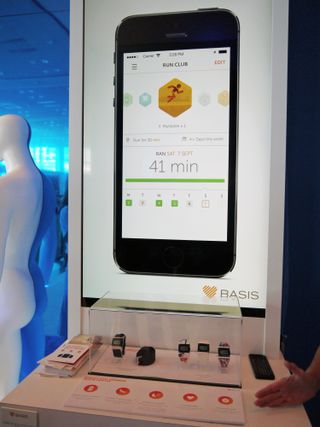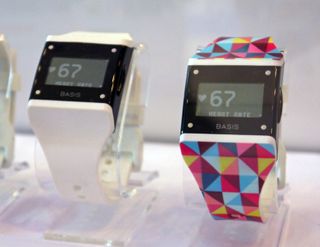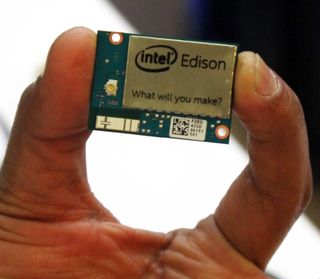Intel’s Curious, But Possibly Brilliant, Wearables Strategy
Intel's wearables strategy is not what you'd expect from the chipmaker. Also: Tizen lives!

Even though "wearables" is the big-time tech buzzword of the day, and there are plenty of wearables (especially smartwatches) popping up all over the place, the industry is still waiting for that must-have device that sets users' hearts alight. No one has quite figured out the secret sauce yet, but going into IDF 2014, my hopes were high that Intel would debut a wearables platform to push the market to a new level of technological heights.
After all, Intel had been talking quite a bit about wearables ahead of the show, so it follows that the chipmaker would have something juicy in store. A whole new SoC platform, perhaps?
The keynote came and went with only basic talk of wearables and some onstage glad-handing with partners — decidedly non-tech partners, notably — and the wearables mega-session the following day was just more of the same.
"Strange," I thought, "but no matter; we'll hit Intel's wearables section on the show floor and all will be illuminated."
Tucked away in its own special place, the wearables area was populated with a handful of simple but elegant product displays. While the selection was somewhat sparse, it included the MICA fashion smart bracelet, the Basis smartwatch, the SMS Audio BioSport smart earbuds and a couple of other miscellaneous items.

Eager, smiling presenters approached as many passersby as possible to show them Intel's wares. We asked them questions about the devices, but all we got were surface-level answers.
The MICA bracelet was designed by a company called Opening Ceremony and sports a 3G radio (which we've now discovered is the XMM 6321), making it a device that doesn't need to be paired with a smartphone. AT&T will offer some sort of connectivity plan. There's also a 1.6-inch touchscreen that resides on the underside of the wearer's wrist.
Stay on the Cutting Edge
Join the experts who read Tom's Hardware for the inside track on enthusiast PC tech news — and have for over 25 years. We'll send breaking news and in-depth reviews of CPUs, GPUs, AI, maker hardware and more straight to your inbox.

We also looked at the Basis smartwatch, which boldly claims to be "the world's most advanced health tracker." "Get fit," "Sleep better," "Stress less," says the handy product brochure. Basis (which is actually an Intel company) offers "four advanced sensors" on its smartwatch that can calculate your heart rate over a period of days, even when you're sleeping and exercising, and it tracks your motion and perspiration to give you a more accurate picture of your health and sleep habits. A mobile app compiles all that data to give you suggestions for ways to tweak your daily routine to improve your health. It also syncs with your mobile device. The 2014 Carbon Steel Edition will cost $199 when it's released in time for the holiday season.
"But what's inside the smart bracelet and smartwatch?" we asked the booth attendants. We didn't get any answers. When we finally cornered a member of Intel's strategic marketing and SoC roadmap team, he wasn't able to give us much either (presumably mostly for NDA reasons), which seemed odd.

What gives? Does Intel even have a wearables strategy? Is the company building a platform at all? Are all of the devices we saw at IDF just empty shells at this point?
We left IDF knowing hardly more about the technology inside Intel's wearables than we did before we came, but upon our return we were able to sit down with Ellen Healy, Intel's PR manager for wearables, and she helped us understand what's going on, and what Intel is up to.
Step 1, Create Market; Step 2, Dominate
Here's Intel's master plan in a nutshell: Yes, the technology is coming, and some of it is already here, but instead of partnering with the industry names you'd expect, Intel is looking to work with companies and brands outside the tech world.
Intel is taking a two-step approach. Step one is partnering with fashion brands, in whatever capacity makes sense, to create a wider market and stronger demand for wearable technology. Step two is swooping in with an SoC platform to cash in on the demand and win the lion's share of that market.
The first part of the strategy seems quite unlike Intel, and at first blush the scheme of partnering with non-tech companies comes off as weak sauce; but it may actually be brilliant.
Healy told us that Intel wants to enhance what's already on the body today. People have been wearing watches for generations, for example, so it follows that a watch company such as Fossil would be a good partner for making a wearable that it, if you'll excuse the expression, is actually wearable.
But it's a two-way street. "The technology is informing the form factor, and while the technology is definitely important — and we don't want to lose sight of that — we're looking to advance what's really going to be feasible and viable for adoption," said Healy.
Even so, what threw me was that I was expecting Intel to roll out a chip family, just as it did with its Core M line of processors for the 2-in-1 market. But Intel's initial push into wearables is not about a line of SoCs.
"We're approaching it from a device to device basis," said Healy. "So take for example the SMS Audio earbuds we announced. We gave them the intelligence; what makes them a 'smart' pair of earbuds is the biometric technology. It's a Texas Instruments microcontroller versus a microprocessor."
She said that the functionality really varies according to the purpose of a given device, and Intel is leveraging existing Intel IP (and existing Intel products) and plugging that into a device that warrants it.
Intel wants to be flexible here, figuring out what technology could work for which products that its non-tech partners are creating. These creations are not for early adopters, and they're not for enthusiasts; they're aimed at that vast mainstream market — you know, the one that buys mountains of smartphones and PCs every year.
Towards An SoC Roadmap (And Tizen Lives!)
Intel may be onto something here; it actually makes loads of sense to implement existing technology into products people actually want to purchase and wear, and allowing fashion and accessory designers to make the products attractive.
Frankly, it's fairly easy, compared to what the rest of the tech industry has been trying to figure out in wearables. Intel doesn't need to create the Next Big Thing in smartwatches; it can instead help make dozens of different smartwatches — and bracelets, and earbuds and so on.
The SMS Audio earbuds are a great example. There's no operating system there, no special SoC; they simply have a microphone and an optical sensor to track your heart rate, and they draw power from your smartphone while you listen to music or podcasts. The earbuds don't really need to do anything much beyond that, do they?
Still, as it turns out, the second prong in Intel's wearables strategy is significantly more Intel-like.
"We are working on SoCs that are specifically customized for wearables, so that is on our product roadmap," Healy said. "We're focused on creating reference designs and an end-to-end solution — software to security to hardware — that really empowers partners to develop cutting-edge products that are going to make wearables technology mainstream and viable."
Aha. Now we're talking.
There are teams at Intel working together on this technology, including software and hardware designers, mechanical engineers, and UX designers. There's an ecosystem brewing, but it will be wide open, unlike the vertically-integrated approach of iOS and Android.
"We're not building any one platform for all of the devices, because ultimately, the devices are going to be delivered by our partners," noted Healy. "We don't want to create vertically-integrated silos that tie you down to one platform."
Intel is using the Tizen IVI OS, as well as HTML5, and the company is relying heavily on third parties to round out the final product offerings, in terms of applications.

Intel's Edison is certainly part of the picture, but it's by no means the premier platform for wearables. It's physically too large to be elegantly integrated into many wearable devices, although it can be used in plenty of products and scenarios. Edison is really ideal for makers and inventors creating small form factor and Internet-connected devices as opposed to harder-core tech designers who will use Intel SoCs to create more "serious" wearable tech.

Thus, the deluge of Intel-powered wearables developed by many of the OEMs you'd expect is coming. When it's coming is not something Intel will share at this point. In the interim, you'll soon be able to buy all manner of traditionally non-tech accessories and products that Intel has "smartened" (I'm claiming that term right here and now).
So many of us have been waiting for some company to create that perfect smartwatch, the one that finally solves all of the issues most people have with wearables, but the solution may in fact be something completely different. Time will tell if Intel's two-staged approach to wearables is the smart bet, but it's certainly unique in the marketplace. And it might actually be the best wearables strategy we've heard of so far.
Follow Seth Colaner @SethColaner. Follow us @tomshardware, on Facebook and on Google+.
-
Steve Simons Though I really like the Apple Watch, these wearables all look very cheap and poorly constructed in comparison.Reply -
serendipiti I think that wearables are a distinct market. The fashion, the status-quo that some trademarks give, are a factor to consider.Reply
Watches perhaps are a perfect example:
Watches are no longer a tool, are more a kind of a jewel. So I think it makes more sense to have big trademarks on that space to make smart watches as jewelry: Rolex, etc...
Heart rate monitoring and sports-bands offer another market which has nothing to do with the jewelry watches, but I don't think its usefullness make for a whole new device like a watch: a bluetooth enabled band that will act as phone's plugin is enough probably.
Most Popular

